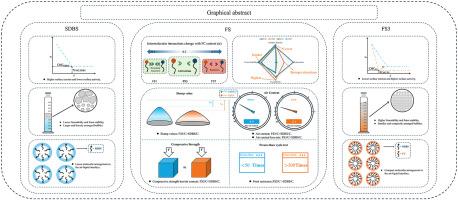应用复合原理优化十二烷基苯磺酸钠吸气剂的效果
IF 7.4
2区 工程技术
Q1 CONSTRUCTION & BUILDING TECHNOLOGY
引用次数: 0
摘要
为了优化十二烷基苯磺酸钠(SDBS)的药效,采用添加氟碳表面活性剂(FC)并改变其摩尔分数的复合工艺。通过调节FC和SDBS的比例,制备了一系列复合引气剂(caea),并对其泡沫性、泡沫稳定性和表面张力进行了表征,同时计算了分子相互作用。结果表明,caea中FC的摩尔分数为0.3的FS3,由于FS3中存在正分子相互作用,具有最高的泡沫性和更大的泡沫稳定性。为此,制备了FS3混凝土(FS3/C),并对其性能和孔隙特性进行了测试和分析。以掺入SDBS (SDBS/C)的混凝土为对照。研究结果表明,与SDBS/C相比,FS3/C的空气含量增加0.5%,随着时间的推移,空气含量损失减少31.9%,坍落度增加9.4%,抗压强度损失也相当。更值得注意的是,SDBS/C在50次冻融循环后被破坏,而FS3/C在300次冻融循环后质量损失仅为2.54%,相对动弹性模量高达88.9%。抗冻性能较好是由于孔径减小了12.1%,孔间距因子(L)减小了12.7%。综上所述,通过调整fc与SDBS的比例,采用复合技术优化基于SDBS的引气剂是有效的。本文章由计算机程序翻译,如有差异,请以英文原文为准。

Applying compound principle to optimizing the efficacy of air entraining agent based on sodium dodecyl benzene sulfonate
To optimize the efficacy of sodium dodecyl benzene sulfonate (SDBS), a compound technology was employed by adding fluorocarbon surfactant (FC) and changing its mole fraction. A series of compound air entraining agents (CAEAs) were prepared by adjusting the ratio of FC and SDBS, and characterized in terms of foamability, foam stability and surface tension, while the molecular interaction was calculated. The results showed that FS3, with the mole fraction of FC being 0.3 in CAEAs, had the highest foamability and greater foam stability because there was a positive molecular interaction in FS3. Thus, concrete with FS3 (FS3/C) was prepared, and its performance and pore characterization was measured and analyzed. Concrete with SDBS (SDBS/C) was served as the control. The findings demonstrated that FS3/C possessed a 0.5 % increase in air content, a 31.9 % reduction in air content loss over time, a 9.4 % increase in slump, and a comparable compressive strength loss relative to SDBS/C. More notably, SDBS/C was destroyed after 50 freeze-thaw cycles, whereas FS3/C showed only a 2.54 % mass loss and a relative dynamic elastic modulus as high as 88.9 % after 300 freeze-thaw cycles. The better frost resistance was attributed to the smaller pore diameter reduced by 12.1 % and the smaller pore spacing factor (L) reduced by 12.7 %. Therefore, it could be concluded that employing compound technology to optimize the air entraining agent based on SDBS by adjusting the FC-to-SDBS ratio was effective.
求助全文
通过发布文献求助,成功后即可免费获取论文全文。
去求助
来源期刊

Journal of building engineering
Engineering-Civil and Structural Engineering
CiteScore
10.00
自引率
12.50%
发文量
1901
审稿时长
35 days
期刊介绍:
The Journal of Building Engineering is an interdisciplinary journal that covers all aspects of science and technology concerned with the whole life cycle of the built environment; from the design phase through to construction, operation, performance, maintenance and its deterioration.
 求助内容:
求助内容: 应助结果提醒方式:
应助结果提醒方式:


